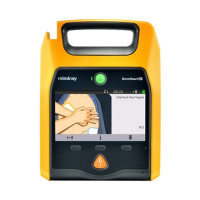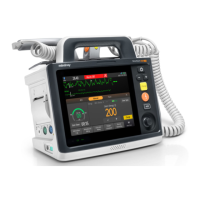25 - 1
25 Maintenance
25.1 Maintenance Safety Information
• Stop using the equipment for any signs of visible damages. If damaged, contact your service
personnel.
• Follow the maintenance and testing schedule or local regulations to perform testing and
maintenance.Not implementing the maintenance schedule may cause equipment failure and
possible health hazards.
• No modification of this equipment is allowed.
• This equipment contains no user serviceable parts.
• Do not open the equipment housings. The safety checks or maintenance involving any disassembly
of the equipment should be performed by professional servicing personnel. Otherwise, undue
equipment failure and possible health hazards could result.
• Do not touch any connected electrode pads or external paddles with hands during auto test and
user test. Otherwise, electric shock could result.
• The service personnel must be properly qualified and thoroughly familiar with the operation of the
equipment.
• The equipment and accessories shall not be served or maintained while in use with a patient.
• If a problem occurs to the equipment, contact the service personnel.
• At the end of its service life, the equipment, as well as its accessories, must be disposed of in
compliance with the guidelines regulating the disposal of such products. If you have any questions
concerning disposal of the equipment, please contact Mindray.
• If needed, contact the manufacture for circuit diagrams, component part lists, descriptions,
calibration instructions, or other information concerning the repair of the equipment.
25.2 Routine Maintenance
25.2.1 Auto Test
• If the equipment is turned off, it can carry out the auto test only when it is either connected with the
external power supply or installed with a battery (at least 60% of battery capacity).
• The auto test simulates the discharge test through impedances in the paddle tray. The auto test
passes only when external paddles properly contact the metal parts of the paddle tray.
• Thoroughly clean the external paddles and properly place them in the paddle tray after each use.
Otherwise, the auto test may fail or damaged external paddles may result.
• The auto test reduces the battery power. If the equipment is not connected to the external power
supply immediately, low battery may result.
• Before the auto test, check that the equipment is connected to the external power supply with a
battery installed, and external paddles are properly placed in the paddle tray or the equipment is
connected with the pads cable and 50 Ω test load. If the pads cable is not connected with the 50 Ω

